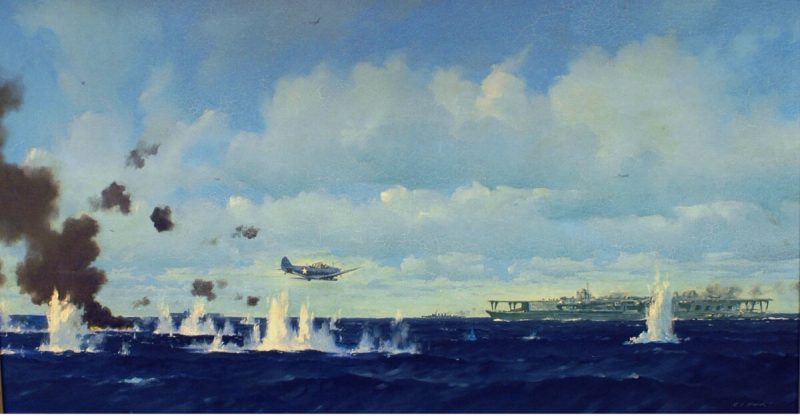The Battle of Midway (3rd to 7th June 1942) was the single most decisive encounter in the Pacific theater of World War Two. A clash between the American and Japanese navies, it saw the Americans get revenge for the ships lost at Pearl Harbor and turn the tide of the war. After Midway, Japanese expansion ended, and the Americans began the island-hopping campaign that would roll Japanese forces back all the way to their home islands.
The Japanese Plan
In June 1942, Admiral Yamamoto, commander of the Japanese navy, was focused on pushing back the American fleet. While indecisive, the Battle of the Coral Sea had halted the Japanese advance on Port Moresby, making the Americans a real hindrance to expansion.
On top of this, the American fleet had struck the Japanese mainland on 18th April, with the Doolittle Raid. Though the bombers that made this attack were unable to return to their ships, they proved the reach of the US Air Force through naval carriers.
Yamamoto decided to expand the fleet’s outer perimeter by taking Midway Island. This would provide a staging point for further attacks on Pearl Harbor, and if Pearl Harbor could be taken, then the US would be driven out of the western Pacific. This was about more than mere expansion – it was about dispersing what remained of the enemy fleet.
To achieve this, Yamamoto split his fleet in two, with troop transports and a carrier fleet approaching from different directions.
The American Response
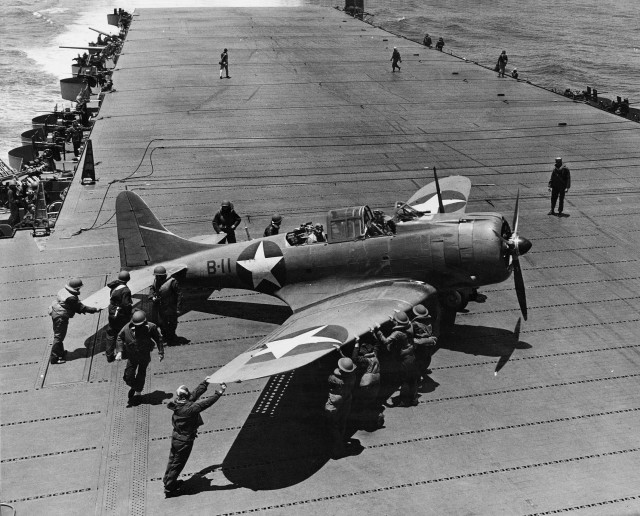
Admiral Nimitz, in charge of the American fleet, had some concept of what he was facing. Intelligence operatives had broken Japanese codes, and so he was able to read some of his opponents’ orders. He gathered his forces to defend Midway.
The ships he assembled were split into two carrier groups. One, under Rear Admiral Spruance, contained two carriers – the Hornet and the Enterprise. The other, under Rear Admiral Fletcher, had at its heart a single carrier – the Yorktown. Badly damaged at the Battle of the Coral Sea, the Yorktown had received 48 hours of frantic repairs to make her battle-worthy.
Arrival at Midway
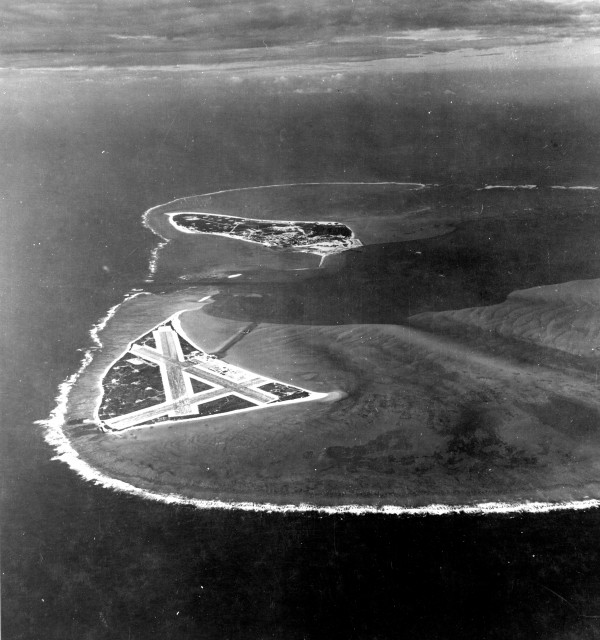
On 3rd June, an American flying boat spotted the Japanese invasion force 700 miles off the west coast of Midway. Flying Fortress bombers were sent out, but by the time they reached the Japanese fleet they were running low on fuel. With anti-aircraft fire hurtling around them they hastily dropped their bombs, hitting only open water.
Early the next morning, bad news arrived. Another flying boat had spotted the second Japanese fleet, the one centered around aircraft carriers, hundreds of miles closer than the invasion force.
Planes from the American base on Midway clashed with those of the Japanese fleet, as the two sides tried to bomb each other. Nimble Zero fighters gave the Japanese the upper hand, and the Americans suffered heavy losses in the early dogfights.
The Fleets Clash
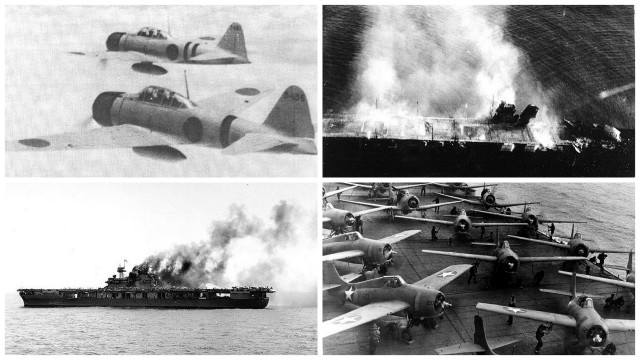
Now came the Japanese turn for bad news, as the combined American fleet was spotted 200 miles away – well within range to launch a bomber attack.
Spruance timed his attack carefully, waiting until the Japanese would be pulling back their planes to refuel. The first three waves of bombers and torpedo planes from the American carriers still suffered terrible casualties to little effect, thanks to the Zeros defending the Japanese carriers. But by the fourth wave the Zeros had also had to land to refuel. With few enemy fighters in the air, the Americans were able to cripple three Japanese carriers – the Kaga, the Soryu, and the Akagi. Because the Japanese planes were on deck to re-arm and re-fuel, many were destroyed where they sat.
The Yorktown
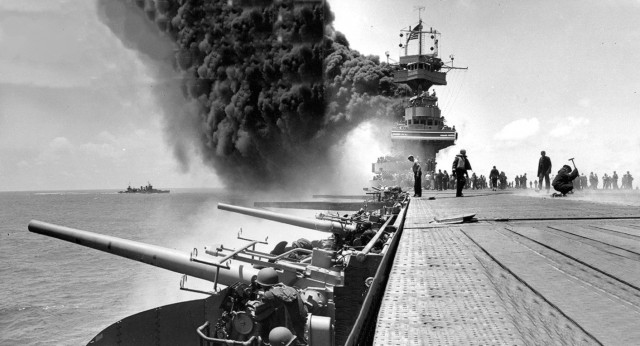
While this was happening, a group of bombers from the Hiryu were on their way to attack the Yorktown, flying with six Zeros for support. Spotted 46 miles out, most of them were shot down by American fighters. But three bombs hit the Yorktown, knocking out the engine room and starting fires that threatened the explosive supplies of fuel and ammunition.
Captain Elliot Buckmaster and the rest of the crew raced to save the Yorktown. Fires were brought under control with great loss of life. Engineers got the ship moving again. A huge new Stars and Stripes flag was raised above the ship.
But a wave of torpedo planes now arrived. Again, most were shot down, but most were not enough. Two hit the Yorktown below the waterline. Lights, power, and communications all went out as the carrier started listing to port. At last, Buckmaster gave the order to abandon ship.
Yorktown’s Revenge
Up until now, the Japanese carrier Hiryu had managed to avoid attacks by American planes. That was about to end, as a scout plane spotted the carrier. Twenty-four Dauntless, ten of them originally from the Yorktown, set off from the Enterprise, followed by sixteen dive-bombers from the Hornet.
They were intercepted by Zeros, but this time, most of the attackers got through. Four bombs hit the flight deck of the Hiryu, starting fires that the crew was unable to bring under control. The Zero fighters, running out of fuel and with nowhere to land, were forced to ditch in the sea.
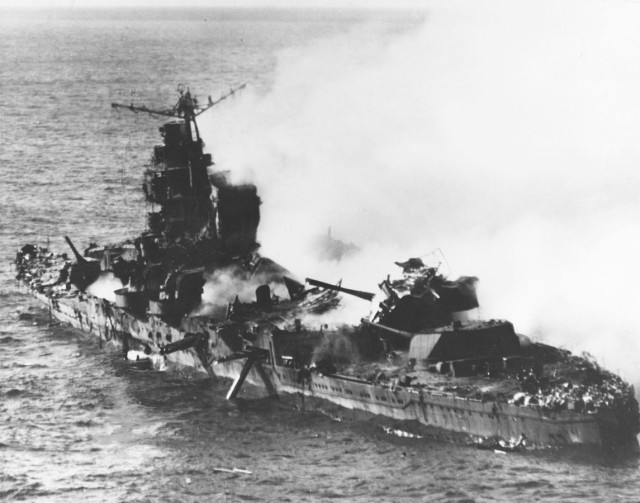
Yamamoto still hoped to reach Midway with his invasion force. Without cover from the carriers, and with American bombers flying from the island, his only hope to do this safely was under cover of night, and he pushed for this. But then word arrived of the other American carriers in the area, and that two of the cruisers with which he wanted to bombard the island would not arrive by nightfall. At three in the morning on the 5th June, he reluctantly gave the order canceling the invasion of Midway.
Aftermath
The Hiryu was eventually abandoned and sunk. The Yorktown was torpedoed by a Japanese submarine while being towed to Pearl Harbor, and she too sank.
Japanese pilots had out-matched the Americans in the skies above Midway, but still been unable to protect their fleet, and so had been lost along with their carriers. The Americans could afford to build new aircraft carriers. The Japanese fleet, now a ghost of its former glory, could not.
The Americans now controlled the seas, and could commence the bloody campaign to retake the scattered islands of the Pacific.
